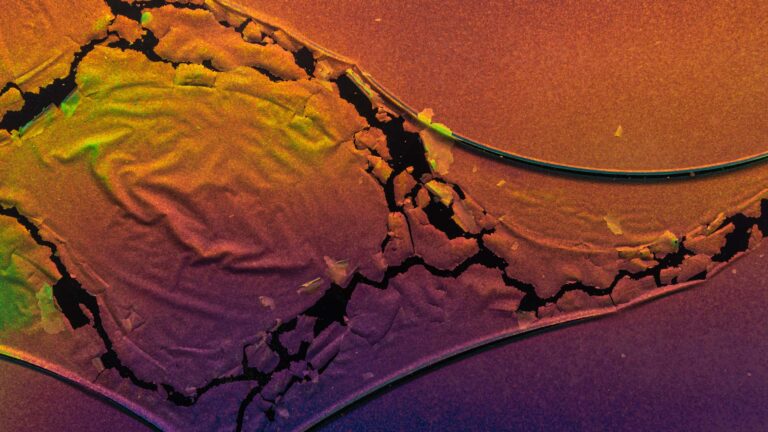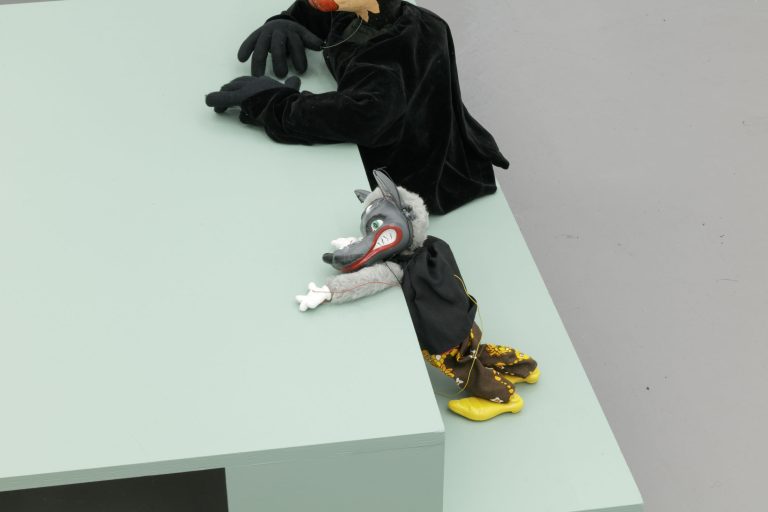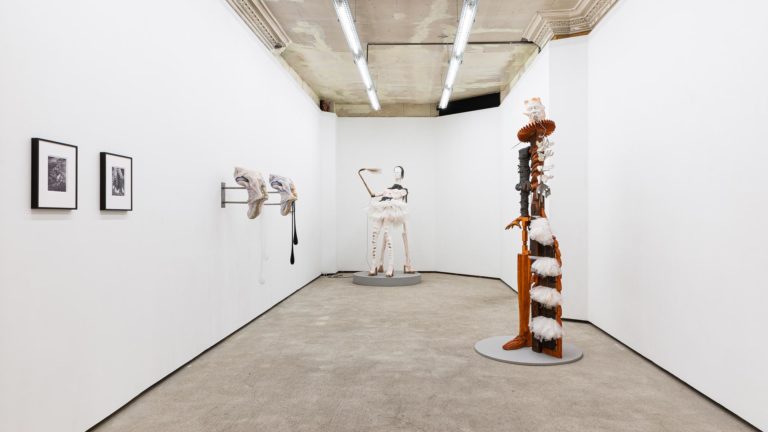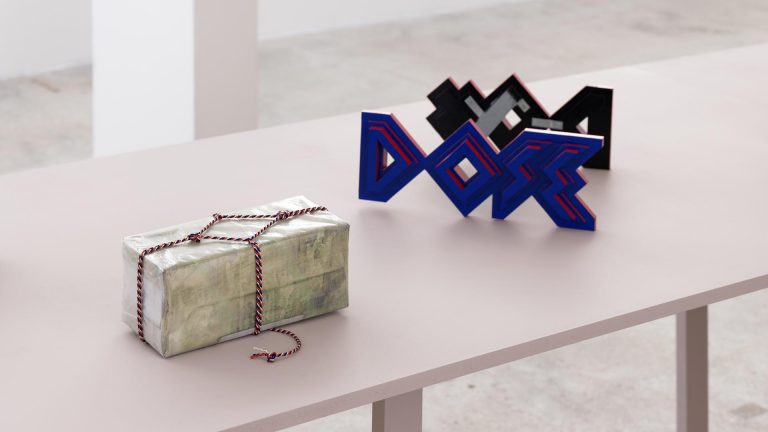Artists: Eleanora Antinova, The Atlas Group, Jack Blevins, Collection Yoon Ja & Paul Devautour, Marcelo do Campo & Marcelo Cidade, René García Atuq, Pedro Manrique Figueroa, Joaquim Nunes de Souza, Naranja M. Q. & Clara S. & Helena L. & Javi L. & the Beggar, Euclides Terra, Juan Trepadori, Luis Camnitzer, José Guillermo Castillo, Liliana Porter, Luis Ospina
Exhibition title: Trust in Fiction
Curated by: Santiago García Navarro and Elfi Turpin
Venue: CRAC Alsace, Altkirch, France
Date: February 21 – May 15, 2016
Photography: all images copyright and courtesy of the artists and CRAC Alsace
Trust in Fiction brings together fictional artists whose thoroughly real works, coming from a range of very different artistic, historical and political contexts, are encountering each other for the first time here in Altkirch.
The exhibition focuses on different conceptual and critical strategies enabling artists to develop a body of work by absorbing the subjectivity of invented authors. Freeing the artist from the constraints of space, time and genre, these strategies make possible the construction of an oeuvre at once hybrid, flexible and open-ended.
One strategy can consist in (re)inventing certain aspects of History. By introducing a fictive character into a given historical context – as The Atlas Group (Walid Raad) did with Doctor Fakhouri or Dora Longo Bahia with Marcelo do Campo and Marcelo Cidade – artists tend to broaden their spectrum of tools as a way of investigating historical figures and processes, thus giving tangible expression to narratives left latent, not to say directly censored or repressed.
Some artists even foreground the falsehood of the historical sources or contexts they invent. When Pedro Manrique Figueroa deliberately alters data with no effort to disguise the fact, the liberties he takes demonstrate on the one hand that history is an unstable product subject to the uncertainties of the imagination, and on the other that verifiable information may not be an essential resource.
The presence of Eleanora Antinova (Eleanor Antin) in Diaghilev’s Ballets Russes displaces the issues of gender and race discrimination into a historical space-time in which the problem was not raised publicly; opening up a new context for considering them.
Another strategy can involve preventing the artist’s univocal body from getting in the way of ideas. Thus Yoon Ja and Paul Devautour exit their own bodies to build up a metacollection of works by twenty-some «bodiless» artists whose many real concerns fuel a vast critical programme that uses fiction to deconstruct the art system on a scale of 1:1.
These fictional artists emerge in negative through their works, but they would not exist without biographies, however erratic and minimal. Without biography there can be no narrative, and without narrative, there can be no invented subjectivity. One of the ways of producing these biographies can be to legitimate minor or unknown artists and works. Thus Juan Trepadori, at least four of Marisa Rubio’s five personages, and Joaquim Nunes de Souza – amateurish, mediocre or simply unaware of their (relative) talent – would never have found a place in history if they had not become implicated in artistic operations which, in one way or another, exceed them.
One of these operations consists in infiltrating a real situation. Trepadori, Antinova, and the artists created by Rubio or The Atlas Group exist on fictional planes very close to reality. So much so that their mission could be summed up as fostering the connections between these parallel planes and the real. Contrariwise, there are others who do not live under the limitations of our world frontiers, their visions being too different from ours. Euclides Terra, a ceramicist fascinated by myths and cosmic movements of energy, and René Garcia Atuq, whose concept of time defies our truths, have the ability to embody experimental systems of perception capable of serving as tools for thinking and acting.
If a fictive artist has the power to inhabit not only one but multiple fictional planes, might not this multiplicity inspire us to numerous forms of existence?
S. G. N. & E. T., February 2016.
Design by Ronnie Fueglister
René García Atuq, With the Future Behind Them, 2016
René García Atuq, With the Future Behind Them, 2016
René García Atuq, With the Future Behind Them, 2016
Joaquim Nunes de Souza, L’Ethnographe naïf 1999-2003, 2009-2010
Joaquim Nunes de Souza, L’Ethnographe naïf 1999-2003, 2009-2010
Joaquim Nunes de Souza, L’Ethnographe naïf 1999-2003, 2009-2010
Euclides Terra, Os 12 filhos de Nossa Senhora do Alto do Moura
Euclides Terra, Os 12 filhos de Nossa Senhora do Alto do Moura
Euclides Terra, Os 12 filhos de Nossa Senhora do Alto do Moura
Euclides Terra, Os 12 filhos de Nossa Senhora do Alto do Moura
Euclides Terra, Os 12 filhos de Nossa Senhora do Alto do Moura
Jack Blevins, Because this is what he’s been doing, 2012
Naranja M. Q. & Clara S. & Helena L. & Javi L. & le Mendiant, 2011-2013
Naranja M. Q. & Clara S. & Helena L. & Javi L. & le Mendiant, 2011-2013
Naranja M. Q. & Clara S. & Helena L. & Javi L. & le Mendiant, 2011-2013
Naranja M. Q. & Clara S. & Helena L. & Javi L. & le Mendiant, 2011-2013
Pedro Manrique Figueroa, The Museum of Poverty, 2006-2016
Pedro Manrique Figueroa, The Museum of Poverty, 2006-2016
Pedro Manrique Figueroa, The Museum of Poverty, 2006-2016
Marcelo do Campo, À bout de souffle, 1969
Pedro Manrique Figueroa, The Museum of Poverty, 2006-2016
Pedro Manrique Figueroa, The Museum of Poverty, 2006-2016
Pedro Manrique Figueroa, The Museum of Poverty, 2006-2016
Pedro Manrique Figueroa, The Museum of Poverty, 2006-2016
Eleanora Antinova, Recollections of my life with Diaghilev 1919-1929, 1973-1979
Eleanora Antinova, Recollections of my life with Diaghilev 1919-1929, 1973-1979
Eleanora Antinova, Recollections of my life with Diaghilev 1919-1929, 1973-1979
Eleanora Antinova, Recollections of my life with Diaghilev 1919-1929, 1973-1979
Pedro Manrique Figueroa, The Museum of Poverty, 2006-2016
Marcelo do Campo, À bout de souffle, 1969, Moeda Capital, 2005
Marcelo Cidade, Moeda Capital, 2005
Marcelo Cidade, Moeda Capital, 2005
The Atlas Group, The Fakhouri File, 1996-2002
The Atlas Group, The Fakhouri File, 1996-2002
The Atlas Group, The Fakhouri File, 1996-2002
The Atlas Group, The Fakhouri File, 1996-2002
The Atlas Group, The Fakhouri File, 1996-2002
The Atlas Group, The Fakhouri File, 1996-2002
The Atlas Group, The Fakhouri File, 1996-2002
Juan Trepadori, Sans titre, Juan Trepadori, Documents 1965-1973
Juan Trepadori, Documents 1965-1973
Liliana Porter, Untitled (The New York Times, Sunday, September 13, 1970), 1970
Juan Trepadori, Documents 1965-1973
Eleanora Antinova, From the Archives of Modern Art, 1987
Eleanora Antinova, From the Archives of Modern Art, 1987
Eleanora Antinova, From the Archives of Modern Art, 1987
Martin Tupper, Show Room Collection Yoon Ja & Paul Devautour, 1993
Martin Tupper, Show Room Collection Yoon Ja & Paul Devautour, 1993
Martin Tupper, Show Room Collection Yoon Ja & Paul Devautour, 1993
Martin Tupper, Show Room Collection Yoon Ja & Paul Devautour, 1993
Martin Tupper, Show Room Collection Yoon Ja & Paul Devautour, 1993
Martin Tupper, Show Room Collection Yoon Ja & Paul Devautour, 1993
Martin Tupper, Show Room Collection Yoon Ja & Paul Devautour, 1993
Martin Tupper, Show Room Collection Yoon Ja & Paul Devautour, 1993
Eleanora Antinova, Recollections of my life with Diaghilev 1919-1929, 1973-1979
Luis Ospina, Un tigre de papel (Un tigre de papier), 2008
Luis Ospina, Un tigre de papel (Un tigre de papier), 2008
Luis Ospina, Un tigre de papel (Un tigre de papier), 2008
Luis Ospina, Un tigre de papel (Un tigre de papier), 2008





































































